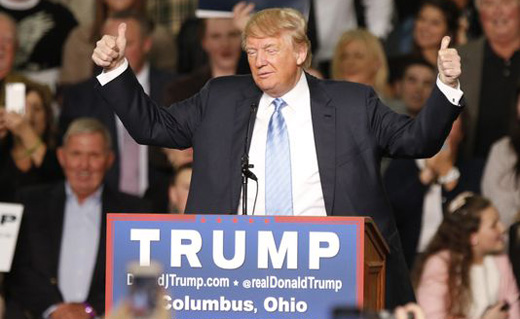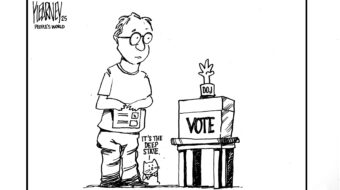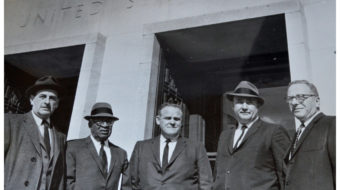
SAN DIEGO (PAI) – Why do working-class people vote for Donald Trump?
In the wake of the real estate billionaire’s virtual sweep of the latest GOP presidential vote – his 47 percent win, outdoing the next two finishers combined – in the Nevada caucuses, the AFL-CIO is trying to tackle the problem.
To start, union leaders here this weekend were presented with a report that analyzes the reasons white working-class workers back a billionaire who really has none of their interests at heart. Those workers, once a key part of organized labor, are disillusioned with the economy, the government and politicians and many are falling hard for Trump.
The report labor leaders at the AFL-CIO executive council meeting here this week were given, titled “Fighting Right-Wing Populism,” was prepared by Working America, the AFL-CIO’s affiliate that reaches out to working people who agree with many of labor’s economic positions but can’t or won’t join unions. The report focuses on white voters who are seen as susceptible to the Trump message.
Working Americas’ success at reaching these voters, particularly in the suburbs of western Pennsylvania and Ohio, was key to winning as many as half of them to vote for President Obama. Many of those voters now, however, are turning to Trump.
What Working America found, in a 1,689-voter survey of the white working class in suburbs between Cleveland and Pittsburgh is disturbing. The canvassers spent between five and 15 minutes conducting “front porch focus groups” with each voter.
While 53 percent of voters surveyed in January had yet to decide on a presidential hopeful of either party, Trump had a lead among those who already made up their minds. The blowhard billionaire got 18 percent, leading the 16 percent for Democrats Hillary Clinton and Bernie Sanders combined and 13 percent for other GOP presidential hopefuls.
These are the same voters who went 48.4 percent for President Obama in 2012, the report adds. But they feel Obama, like other politicians, has failed them.
“The working class constituents with whom we talk every night are fearful about their economic circumstances and prospects, angry about politicians who fail to address their concerns and skeptical about the role of government,” Working America’s report to the AFL-CIO executive council said.
“Candidates and organizations” – unnamed – “are exploiting these anxieties with their right-wing rhetoric that combines populism and bigotry. This targeted strategy has our core constituency directly in its crosshairs,” it warns.
“Worry is more prevalent than bigotry on voter choice” and Trump’s personality trumps his issue stands, the report says.
The way to trump Trump, the report advocates, is extensive, time-consuming and expensive: individual one-on-one conversations with workers and their families. Some one-third of Trump supporters – ideological conservatives – will not be swayed.
But the other two-thirds of Trump backers are a combination of “fed-up voters” who are concerned with particular issues but who back Trump “because he says what he thinks” and voters who form their impressions of the business mogul from the extensive TV coverage of him, his rallies and his statements.
With Trump apparently on his way to the Republican presidential nomination, Working America recommends the best way to trump Trump is to talk about his real stands, at length. The report says that when this was done with individual voters who knew the Working America canvassers with whom they were speaking voters began to reconsider their positions. The long and short of that is that it will take a massive ground operation of the type only labor and its allies can mount to defeat right wing populism in 2016.
“The disparity between what he says and what he actually does gives voters pause and opened the way to more nuanced conversations” with them about issues ranging from worker rights to immigration to foreign policy, the report says. And as an example of how little voters know or care about Trump on the issues, it reports only four percent list immigration – a big Trump cause – as their top issue this year.
“Fed-up and low-information voters were especially open to new information. For these voters, facts about Trump’s business practices” – including bankruptcies of four of his projects – “implications of his policy positions and questions about the effect his shoot-from-the-hip approach might have on international issues were effective in changing the conversation from simplest initial responses to a more-thoughtful framework.”
Many white working-class voters, the Working America canvassers reported, used their extensive conversations “to dig deeper into their own views” and to eventually change their minds about the big mogul.
While recommending that Working America in particular and organized labor in general continue such extensive discussions with the white working class voters Trump targets, the report did not say how much staff and resources should be put into the effort. That was a topic the council discussed behind closed doors, and staffers declined to put numbers on its plans.
Working America Director Karen Nussbaum had to leave the session early and could not be reached for immediate comment.
The report warned that since Trump announced his candidacy last June, “he has opened up a vein of right-wing rhetoric that has appealed to many Republicans and to middle-of-the-road white working-class Democrats as well.” The dangers of this, the report said, extend beyond the Trump candidacy. “Whether or not Trump becomes the GOP nominee, his candidacy is legitimizing a hard-right agenda among working-class voters, similar to the re-emergence of right-wing political parties throughout Europe.”
During the five weeks of the survey, from Dec. 18, 2015 to January 22, 2016 canvassers reached the 1,689 voters in households with incomes of $75,000 or less in working-class neighborhoods outside of Cleveland and Pittsburgh.
The report ended on a note of hope, however, saying the white working- class voters could trust the Working America canvassers as honest purveyors of factual information. They’re “hungry for an independent voice to deliver information and with whom they can discuss issues” Trump raises, the report says. Working America can be that voice, it advocates.
“Many who said Trump appealed to them ‘because he speaks his mind’ didn’t see a way forward other than through a firestorm of his rhetoric. For some, however, our engagement – a combination of validation and information – gave them pause. The longer we spoke with people, the more opportunity there was to talk issues, not personalities.”
And it views that task as absolutely necessary.
“Without a countervailing pull of authentic engagement about issues and a progressive vision for the future of the country, the appeal of right wing rhetoric” – including that coming from Trump – “will continue,” the report warns.
Photo: Donald Trump speaks at a rally in Ohio. | Paul Vernon/AP











